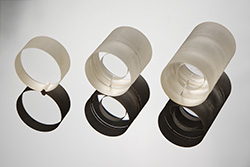free spectral range (original) (raw)
Definition: frequency spacing of the axial modes of an optical resonator
Alternative terms: axial mode spacing, longitudinal mode spacing
Related: cavitiesresonator modesetalonsgroup indexgroup delay
Units: Hz
Formula symbol: ($\Delta \nu$)
Page views in 12 months: 8242
DOI: 10.61835/fx2 Cite the article: BibTex BibLaTex plain textHTML Link to this page! LinkedIn
Content quality and neutrality are maintained according to our editorial policy.
📦 For purchasing etalons, use the RP Photonics Buyer's Guide — an expert-curated directory for finding all relevant suppliers, which also offers advanced purchasing assistance.
Contents
What is the Free Spectral Range of a Resonator?
The free spectral range of an optical resonator (cavity) is the spacing of its axial (Gaussian-shaped) resonator modes in terms of optical frequency. It is also called axial mode spacing. For an empty standing-wave resonator of length ($L$), it can be calculated as \Delta \nu = \frac{c}{{2L}}Fora[ringresonator](ringForastanding−waveresonatorfilledwitha[dispersivemedium](dispersion.html),thefreespectralrangeisdeterminedbythe[groupindex](groupFor a ring resonator, the factor of 2 is removed, since there is no double pass.
For a standing-wave resonator filled with a dispersive medium, the free spectral range is determined by the group index, rather than by the ordinary refractive index:Fora[ringresonator](ringForastanding−waveresonatorfilledwitha[dispersivemedium](dispersion.html),thefreespectralrangeisdeterminedbythe[groupindex](group\Delta \nu = \frac{c}{{2{n_{\textrm{g}}}L}}$$
This follows from the fact that the round-trip phase shift ($2 k L = 2 L n \omega /c$) must change by ($2\pi$) from one resonance to the next one, and only through the group index one considers the full frequency dependence of the round-trip phase shift (including the frequency dependence of the refractive index). Due to chromatic dispersion, the group index can substantially deviate from the refractive index, and it generally is frequency-dependent.
For a waveguide resonator, one would have to calculate the group index using the frequency-dependent effective refractive index.
More generally, e.g. for an optical resonator containing different transparent media, the free spectral range is the inverse of the round-trip time (more precisely, the round-trip group delay) of a light pulse.
Practical Relevance of the Free Spectral Range
The free spectral range of a Fabry–Pérot interferometer (or a Lyot filter) often limits the optical frequency range in which it can be used as a spectrometer. A large free spectral range can thus be desirable. It can be obtained simply by making the resonator shorter — which, however, also leads to a larger bandwidth of the resonances, thus to poorer spectral resolution, as long as the same mirrors are used. For better resolution, one then needs to increase the finesse by minimizing the round-trip power losses of circulating light.
For a wavelength-tunable single-frequency laser, the free spectral range often (but not always) limits the achievable mode-hop-free tuning range.
Frequently Asked Questions
This FAQ section was generated with AI based on the article content and has been reviewed by the article’s author (RP).
What is the free spectral range of an optical resonator?
How can the free spectral range be calculated?
For an empty standing-wave resonator of length ($L$), the free spectral range is ($\Delta \nu = c / (2L)$). If the resonator contains a dispersive medium with group index ($n_g$), the formula is ($\Delta \nu = c / (2 n_g L)$).
How does the resonator length affect the free spectral range?
The free spectral range is inversely proportional to the resonator length. Therefore, a shorter resonator will have a larger free spectral range.
What is the practical importance of the free spectral range?
Suppliers
Sponsored content: The RP Photonics Buyer's Guide contains 33 suppliers for etalons. Among them:
⚙ hardware
ALPHALAS offers etalons made of fused silica for wavelength tuning and single-frequency operation of lasers. Etalons with diameter 8 mm and thicknesses 0.2 mm, 0.9 mm or 1.3 mm, coated with different reflectivities in the near infrared region, are available from stock.
Upgraded to resonant reflectors (stack of very high precision fused quartz flats with spacers and different number of elements), these have very high periodic spectral selectivity and very high damage threshold.
Customer-specific designs are also available.
⚙ hardware
LightMachinery manufactures the world's finest solid and air spaced etalons. Our fluid jet polishing systems allow us to routinely create surfaces that are better than λ/100 peak to valley.
Solid etalons, air spaced etalons, piezo tunable etalons, Gires–Tournois etalons — LightMachinery has extensive expertise in the manufacturing and testing of all kinds of Fabry–Pérot etalons from 1 mm square to 100 mm in diameter. These devices require high quality, very flat optical surfaces and extreme parallelism to achieve high performance, making them a good match for the polishing and metrology at LightMachinery.
Questions and Comments from Users
Here you can submit questions and comments. As far as they get accepted by the author, they will appear above this paragraph together with the author’s answer. The author will decide on acceptance based on certain criteria. Essentially, the issue must be of sufficiently broad interest.
Please do not enter personal data here. (See also our privacy declaration.) If you wish to receive personal feedback or consultancy from the author, please contact him, e.g. via e-mail.
By submitting the information, you give your consent to the potential publication of your inputs on our website according to our rules. (If you later retract your consent, we will delete those inputs.) As your inputs are first reviewed by the author, they may be published with some delay.
 optical resonators
optical resonators


